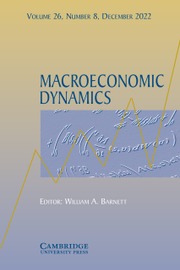No CrossRef data available.
Article contents
Revisiting consumption and income relationship: a vector logistic smooth transition regression modelling
Published online by Cambridge University Press: 10 September 2025
Abstract
This study revisits the relationship between household consumption and its economic (income, wealth, and interest rates) and behavioural drivers. We specify this relationship while allowing for a threshold effect and a switching regime, which help capture further asymmetry, time-variation, and nonlinearity in this relationship. To this end, we specify a vector logistic smooth transition regression (VLSTR) model, which allows modelling the consumption–income relationship in a nonlinear system and provides more concise estimators. We obtain two interesting results. First, the consumption–income relationship is time-varying, regime-dependent, and it exhibits asymmetry and nonlinearity. Second, while household consumption remains driven by usual factors (income, financial wealth, interest rate, and exchange rate), it is also statistically sensitive to factors (consumer sentiment), and this sensitivity is regime-dependent.
Keywords
Information
- Type
- Articles
- Information
- Copyright
- © The Author(s), 2025. Published by Cambridge University Press

